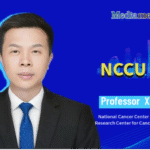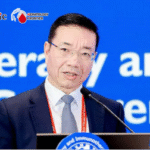
The 67th American Society of Hematology (ASH) Annual Meeting will be held from December 6 to 9, 2025, in Orlando, USA. As one of the largest, most influential, and most comprehensive international congresses in hematology, ASH attracts tens of thousands of experts and scholars from around the world each year to share the latest advances and breakthrough research in the field. Among this year’s accepted abstracts, the study titled “Dual-armoring of CLL-1 CAR-T cells with IL-18 and an RQR8 suicide switch enhances efficacy and safety in Acute Myeloid Leukemia,” jointly led by Zunmin Zhu, Director of Hematology at Henan Provincial People’s Hospital; Mingfeng Zhao, Director of Hematology at Tianjin First Central Hospital; and Wenyi Lu, Hematology Department, Henan Provincial People’s Hospital, attracted significant attention. The work was conducted in collaboration with multiple institutions. This article presents a structured overview of the study for readers.
Abstract Information
Abstract Number: abs25-13470 Publication Number: 4124
English Title: Dual-armoring of CLL-1 CAR-T cells with IL-18 and an RQR8 suicide switch enhances efficacy and safety in Acute Myeloid Leukemia
Chinese Title: IL-18和RQR8自杀开关双装甲CLL-1 CAR-T细胞增强急性髓系白血病的疗效和安全性
Authors: Wenyi Lu¹, Bing Cao¹, Xin Jin², Yuanyuan Hao¹, Lei Zhang¹, Wei Cheng¹, Wei Li¹, Zhenxin Zhao³, Zhoufeng Huang¹, Wenyan Li³, Yuanbo Liu¹, Mingfeng Zhao⁴, Zunmin Zhu¹
Affiliations:
- Hematology Department & Institute of Hematologic Diseases, Henan Provincial People’s Hospital / Zhengzhou University People’s Hospital / Henan University People’s Hospital, Zhengzhou, Henan, China
- Translational Medicine Ward, Sir Run Run Shaw Hospital, Zhejiang University School of Medicine, Hangzhou, Zhejiang, China
- Department of Traditional Chinese Medicine, Hongxing Hospital of the 13th Division, Xinjiang Production and Construction Corps, Hami, Xinjiang, China
- Hematology Department, Tianjin First Central Hospital, Tianjin, China
Study Overview
Introduction
Relapsed or refractory acute myeloid leukemia (R/R AML) remains a major therapeutic challenge with limited treatment options. Although CLL-1–targeted CAR-T therapy has shown promise, response rates remain suboptimal. In our previous proteomic analysis, we observed elevated serum IL-18 levels in patients who achieved remission, suggesting a potential role in therapeutic efficacy. To enhance antileukemic activity while reducing toxicity, we designed CLL-1 CAR-T cells co-expressing IL-18 and the RQR8 safety switch.
Methods
We constructed a dual-armored lentiviral vector incorporating a CLL-1–specific CAR (anti-CLL-1 scFv / CD8α hinge / 4-1BB / CD3ζ), IL-18, and the RQR8 suicide switch connected via T2A and P2A peptide linkers.
In vitro, we evaluated proliferation, cytotoxicity, and cytokine secretion of CAR-T cells using AML cell lines with high CLL-1 expression (U937, HL-60), low expression (MOLM-13), as well as primary AML blasts. Colony-forming unit (CFU) assays assessed effects on normal hematopoietic stem/progenitor cells (HSPCs).
In vivo efficacy and survival were assessed in xenograft (CDX) models established from HL-60 and MOLM-13 cell lines.
Results
Compared with conventional CLL-1 CAR-T cells or untransduced T cells, dual-armored CLL-1/IL-18 CAR-T cells showed markedly elevated IL-18 mRNA and protein secretion. These cells exhibited potent antigen-specific cytotoxicity against CLL-1–expressing AML cell lines (HL-60, MOLM-13, THP-1) and primary AML blasts, accompanied by significantly increased IFN-γ and IL-6 secretion upon target engagement.
RNA sequencing revealed upregulation of IL-18, IL-23R, IL-21, IFNG, CXCL10, and IL-7R in CLL-1/IL-18 CAR-T cells, suggesting enhanced effector functionality.
Importantly, CFU assays showed no significant impairment of normal HSPC colony-forming capacity compared with controls, indicating no increased off-tumor toxicity.
In xenograft models, CLL-1/IL-18 CAR-T cells achieved superior tumor control and significantly prolonged median survival compared with conventional CAR-T cells.
CAR-T cells incorporating the RQR8 switch could be efficiently eliminated in vitro using rituximab, completely abolishing cytotoxicity and cytokine secretion. This provides a crucial safeguard against potential IL-18-driven cytokine release syndrome (CRS) or neurotoxicity.
Conclusion
Co-expression of IL-18 substantially enhances the antileukemic efficacy of CLL-1 CAR-T cells both in vitro and in vivo without increasing off-target toxicity toward hematopoietic stem/progenitor cells. Integration of the RQR8 safety switch provides an essential protective mechanism against potential toxicities. This dual-armored strategy represents a highly promising therapeutic approach for patients with R/R AML.


